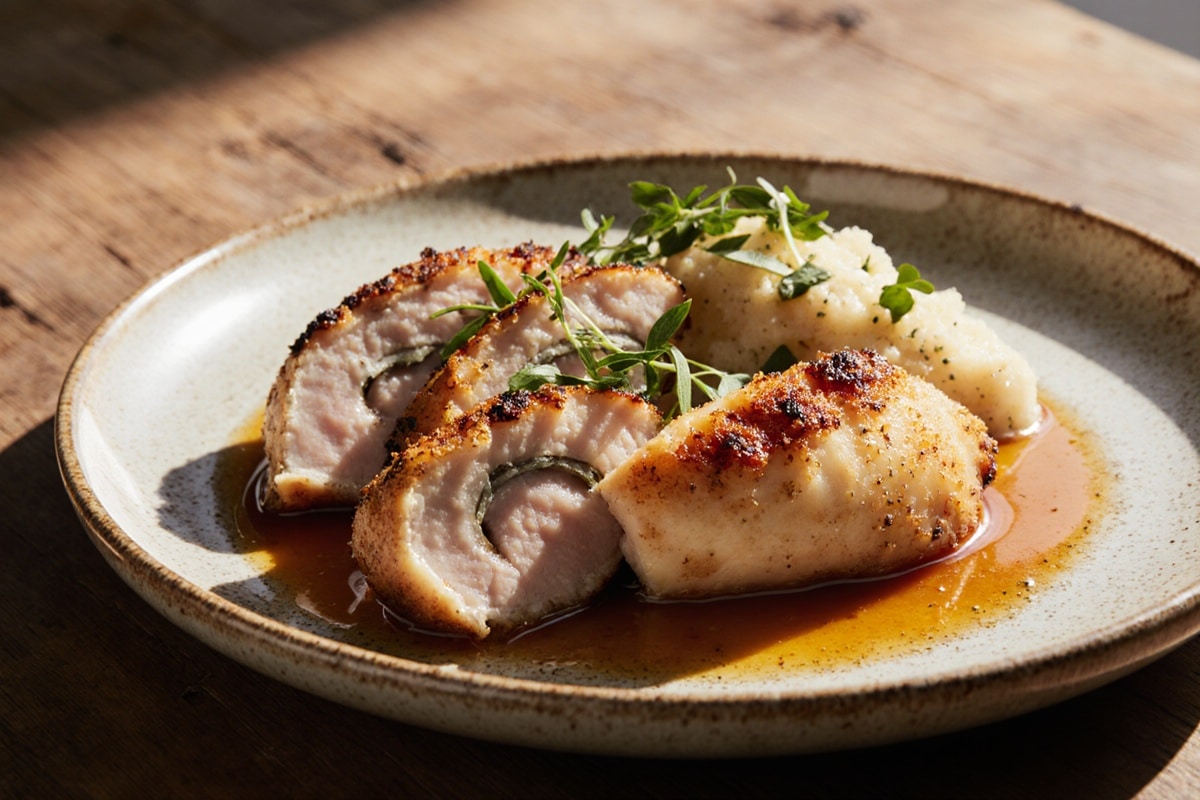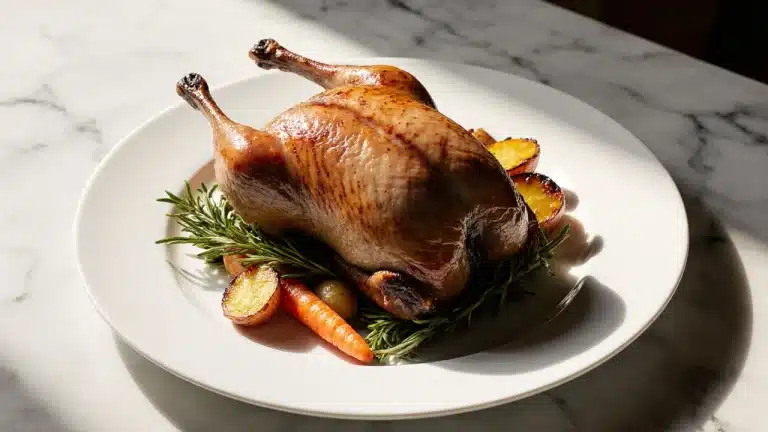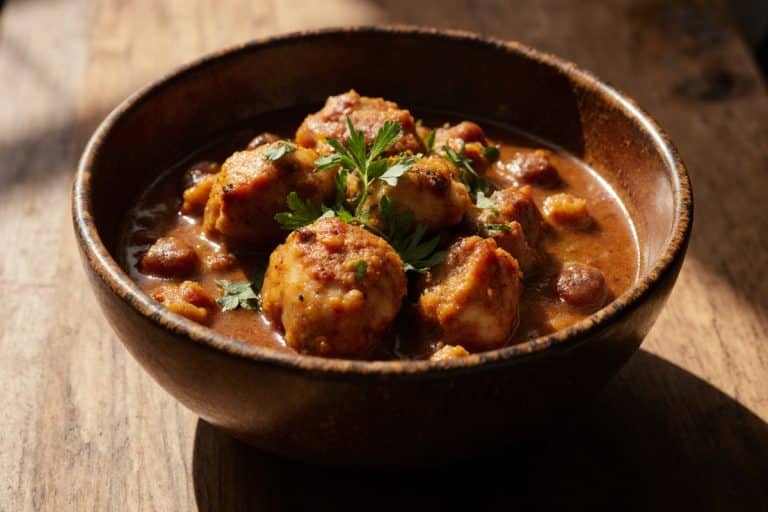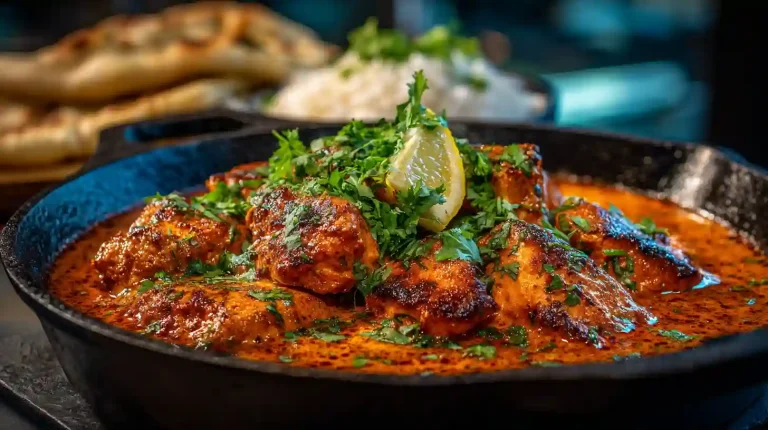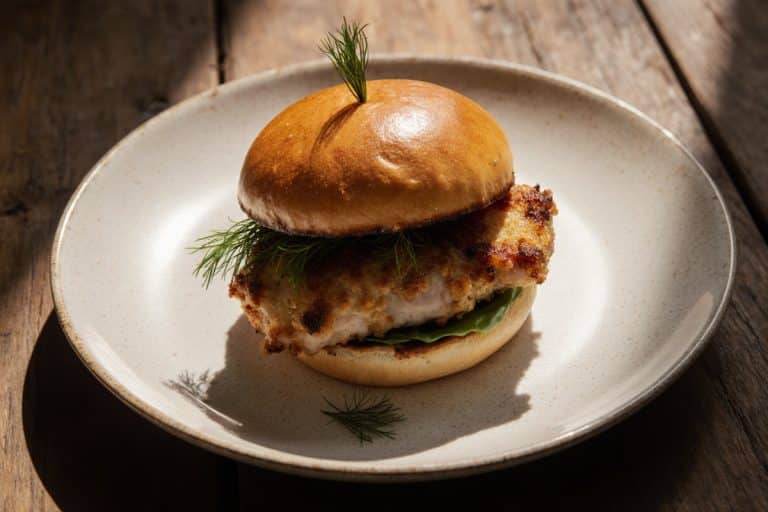Gordon Ramsay Chicken Cordon Bleu Recipe
Gordon Ramsay chicken cordon bleu is a culinary game-changer. I remember making the same tired chicken dinners week after week, drowning them in sauce to hide the lack of flavor. But then, I stumbled upon Ramsay’s technique. It taught me the beauty of crispy, golden-brown chicken rolled around gooey cheese and savory ham. Not only did I save time in the kitchen, but I also built my confidence knowing I could nail a dish that impresses everyone from family to friends. Let’s dive into making this classic dish that’s easier and tastier than you think!

Ingredients, weights and simple prep for a fail-safe cordon bleu
Exact ingredient list and yields
Use boneless, skinless chicken breasts, trimmed and pounded: 4 breasts ≈ 1200 g total (each about 300 g). For filling: 8 thin ham slices (120–140 g) and 200 g Gruyère or Emmental, sliced into 8 pieces about 25 g each. Breading: 60 g plain flour, 2 large eggs (≈100 g beaten), 160 g panko breadcrumbs. Seasoning: 8 g fine salt (about 1½ tsp) and 3 g black pepper (about ¾ tsp), plus 30 g butter and 15 ml neutral oil for frying if pan-finishing. Optional lemon wedges and 60 g Dijon mustard for serving.
This makes 4 portions. Weigh your breasts — don’t guess. If breasts are smaller, use two per portion or cut the filling amounts down. Pounding to a uniform 4–5 mm thickness keeps the cooking even and predictable.
Small prep steps that save your life (and dinner)
Trim visible fat and the thin tendon at the breast base; it curls and rips your roll. Put a breast between two sheets of cling film and pound with a heavy pan until 4–5 mm thick, working from the centre out.
Stack ham and cheese on the flattened breast, leaving a 1 cm border to prevent leaks. Chill assembled rolls for 20–30 minutes before breading—this is the single best trick to stop cheese oozing and crumbs sliding off.
Set up a breading station: flour bowl, egg bowl, breadcrumb bowl. Use one hand for dry (flour) and the other for wet (egg) to keep things tidy.
Equipment and timing — what to have ready
You’ll need a meat mallet or heavy skillet, baking tray, wire rack, three shallow bowls, an instant-read thermometer, and toothpicks or kitchen twine. Preheat the oven to 200°C (400°F) before you bread so everything moves quickly.
Plan about 15 minutes active prep, 20–30 minutes chilling, and 20–30 minutes cook time depending on method. Get the thermometer out — target core temp is 74°C (165°F). Guessing by feel will either give you rubber chicken or a food-safety problem.
How to make gordon ramsay chicken cordon bleu — step-by-step assembly & cook
Building and securing the roll, step-by-step
Lay the pounded breast flat and season with ½ tsp (about 2.5 g) salt and a pinch of pepper. Place two half slices of ham (or one full thin slice folded) and a 25 g slice of cheese in the centre, then fold the long edges over the filling.
Roll tightly from the short side and secure with two toothpicks or tie with kitchen twine. Brush a thin film of mustard inside if you want a bit of tang; it also helps the ham stay put.
If the edges won’t stay, don’t force them — chill 20 minutes then try again. A neat roll equals even cooking and fewer leaks.
Breading and readiness for the oven or fryer
Dredge each roll in flour, tapping off excess. Dip fully in beaten egg, then roll in panko and press lightly so crumbs stick.
Place on a wire rack to rest 10 minutes—this sets the coating. For extra crisp, repeat the egg + panko step for a double crust.
If you see bare spots, patch with a little flour and egg. Don’t overcrowd the tray or fryer — airflow matters. At this stage the rolls can be refrigerated up to 24 hours or frozen uncooked on a tray for 1 hour then bagged.
Oven finish: exact times, temps and signs of doneness
Preheat to 200°C (400°F). Place rolls on a wire rack set over a baking tray and bake 20–25 minutes until golden and an instant-read thermometer reads 74°C (165°F) in the centre. Rotate the tray at 12 minutes for even browning.
If crumbs brown too quickly, tent foil loosely after 12–15 minutes. For a glossy finish, brush melted butter or an egg wash in the last 4 minutes. Rest 5 minutes before serving so the juices settle — cutting too soon = molten cheese explosion.
Cooking method comparisons — oven, pan, air fryer, grill
Oven method — best for even cooking and hands-off service
The oven gives the most predictable result: 200°C (400°F) for 20–25 minutes, target 74°C (165°F) internal. Using a wire rack raises the rolls so hot air crisps all sides and the chicken stays juicy.
This is the method I reach for when I cook more than two rolls. If you’re impatient, a quick sear first gives a head start on colour but the oven still does the final cooking, so don’t skip the thermometer.
Pan-finish method — colour fast, but watch the centre
Sear rolls in 15 g butter + 10 ml oil over medium-high heat for 1–2 minutes per side until golden, then transfer to a 200°C (400°F) oven for 12–14 minutes. Searing gives better colour and a deeper taste, but crumbs burn quickly if the pan’s too hot.
Check for 74°C (165°F) inside. If the crust is done before the centre, drop the oven to 180°C (350°F) and finish gently — saving the crust beats burning it.
Air fryer method — fast, crisp, and efficient
Preheat the air fryer to 180°C (350°F). Cook the rolls for 12–15 minutes, flipping at 7 minutes; they should hit 74°C (165°F). Air fryers crisp panko beautifully with less oil and faster turnaround.
Don’t cram the basket — leave space for air to move. For extra certainty, sear for 1 minute in a hot pan before air frying to lock in colour. The air fryer is a great shortcut when you want dinner now and a crispy jacket.
Grill method — not traditional but possible
Grill indirect over medium heat (190–200°C / 375–400°F). Place rolls on the cooler zone with the lid closed for 18–22 minutes, turning once, until the centre reaches 74°C (165°F). Use a thin grill-safe pan or tray if crumbs would fall through the grates.
This adds smoky notes but can give uneven heat; tent with foil if the top browns too fast. Grill when you want summer flavours, but expect less uniform crust than the oven or air fryer.
Common mistakes, how to fix them, and safety rules
Soggy crumbs or crumb fallout — why it happens and how to rescue
Soggy crumbs usually come from overcrowding, a wet filling, or skipping the chill step. Fix this mid-cook by moving rolls to a wire rack under a hot skillet or into a 220°C (425°F) oven for 2–4 minutes to dry and re-crisp the surface.
If breadcrumbs keep falling off before cooking, press them firmly when breading or double-coat (egg → panko → egg → panko). Set the crumb with a 10-minute rest in the fridge before cooking to keep everything where it belongs.
Undercooked centre or dried-out chicken — diagnosis and cure
An undercooked centre usually means the roll was too thick, the oven too hot, or you skipped the thermometer. Lower the oven to 180°C (350°F) and keep cooking until the core hits 74°C (165°F).
Dry chicken comes from overcooking. Pull at 74°C (165°F) and rest 5 minutes; carryover will finish the job. Thermometer = your most useful tool.
Cheese leak and collapsed rolls — prevention and quick patch
Cheese leaks when the filling’s loose or you didn’t chill the rolls. To prevent this, press the filling snug, leave a 1 cm margin, and chill 20–30 minutes before breading.
If cheese begins to ooze in the oven, slide a sheet of foil under the roll, drop the heat to 180°C (350°F), and let it finish gently. For a quick patch, press edges together, secure with toothpicks, and brush an egg wash to help seal.
Food safety rules — temperatures, storage, and reheating
Cook all chicken to an internal temperature of 74°C (165°F). Refrigerate leftovers within 2 hours and store in a sealed container for up to 3–4 days. Freeze cooked cordon bleu up to 3 months; thaw overnight in the fridge before reheating.
Reheat to at least 74°C (165°F) — use the oven at 170°C (340°F) for 10–15 minutes or the air fryer at 160°C (320°F) for 6–8 minutes. No guessing — always thermometer-check.
Variations, ingredient swaps and creative twists (≥3 ideas)
Classic upgrades — prosciutto & Gruyère, Dijon inside
Swap Swiss/Emmental for Gruyère (200 g) and use prosciutto instead of ham for an upscale version. Add 1 tbsp Dijon (15 g) inside the breast under the ham for a clean tang that cuts the richness.
Prosciutto’s lower moisture keeps the crust crisp and gives a richer flavour. If you want smoky notes, use smoked ham and a touch of smoked paprika (½ tsp, 1 g) in the breadcrumbs.
Lighter or low-carb variants — turkey, low-fat cheese, almond crumbs
Use turkey breast (same weight) for a leaner option; choose a lower-fat Swiss or 150 g reduced-fat mozzarella to cut saturated fat. Replace panko with 160 g finely ground almonds (almond flour plus 40 g coarser crumbs) for a low-carb crust.
When using almonds, fry or air-fry gently at 160–170°C (320–340°F) to avoid burning. Almond crust browns faster, so lower the heat and watch closely.
Vegetarian and non-traditional takes — stuffed aubergine or chicken alternative
For a vegetarian take, use aubergine slices: cut 8 slices 1 cm thick and roast at 200°C (400°F) for 8–10 minutes. Layer with a ham substitute or smoked tofu and cheese, roll, bread and finish 12–15 minutes.
Or try thick chicken-style seitan the same way, using the same temperatures. If you want background on the classic dish, see cordon bleu.
Another option is pork loin steaks, flattened and treated exactly like chicken — cook until they reach 74°C (165°F). These swaps keep the technique while changing the protein.
Sauces and accompaniments to change the mood
Classic: Dijon cream sauce — sauté 1 small shallot (30 g) in 15 g butter, deglaze with 60 ml white wine, stir in 150 ml double cream and 2 tsp Dijon, simmer until thickened. For brightness, squeeze lemon and finish with chopped parsley (10 g).
Other options: mushroom cream, grainy mustard and honey, or a light caper-lemon butter for Mediterranean notes. Sauce makes the dish sing — don’t serve dry protein.
Plating, serving suggestions, nutrition & storage
Two-to-three practical serving suggestions
Serve with buttered mashed potatoes (400 g potatoes, 50 g butter, 60 ml milk) and steamed green beans dressed with lemon and olive oil. For a lighter meal, pair with a crisp salad: arugula, cherry tomatoes, cucumber, and a lemon-Dijon vinaigrette.
For a restaurant feel, slice each roll diagonally and fan on the plate with a drizzle of mustard cream sauce and micro herbs. Keep portions controlled — this is rich food; fresh sides balance the fat.
Rough nutrition notes and benefits (be practical, not perfect)
Per portion expect roughly 35–45 g of protein from chicken and cheese. The dish contains saturated fat from cheese and butter; choosing lean ham or turkey and lower-fat cheese will reduce that. Breadcrumbs add carbs; an almond crust lowers carbs and adds healthy fats.
This is a protein-forward meal with iron and calcium coming from the meat and cheese. If you need exact numbers, weigh finished portions and use nutrition software — cheese type, oil, and sides change totals a lot.
Storage, reheating, and make-ahead tips
Make ahead: assemble and chill for up to 24 hours before breading and cooking, or freeze raw rolls on a tray for 1 hour then bag for up to 3 months. Cook from frozen by adding 5–8 minutes to oven or air-fryer time; always confirm 74°C (165°F).
Leftovers: refrigerate within 2 hours, keep up to 3–4 days. Reheat in the oven at 170°C (340°F) for 10–15 minutes or air fryer at 160°C (320°F) for 6–8 minutes, checking internal temperature. Never microwave to reheat from raw — the crust ruins and the heat is uneven.
Final plating tips to impress without faff
Slice at a 30-degree angle for bigger, sloped surfaces that look showy. Rest rolls 5 minutes to avoid molten-cheese accidents and use a serrated knife for clean cuts.
Garnish simply: chopped parsley, a lemon wedge, and a small spoonful of Dijon cream to the side. Serve on warm plates to keep the crust crisp; cold plates mean soggy crumbs. Presentation matters, but don’t overdo it — a neat slice and hot sauce rescue most dinners.
Fail-Safe Cordon Bleu
Ingredients
Equipment
Method
- Trim visible fat and tendons from chicken breasts. Pound between cling film to 4–5 mm thickness.
- Layer ham and cheese on flattened chicken, leaving a 1 cm border. Roll tightly and secure with toothpicks.
- Chill rolls for 20–30 minutes before breading.
- Set up a breading station with flour, beaten eggs, and panko breadcrumbs.
- Dredge each roll in flour, dip in egg, and coat with panko. Let rest for 10 minutes.
- Preheat oven to 200°C (400°F). Bake for 20–25 minutes until golden and cooked to 74°C (165°F).
- Rest for 5 minutes before serving.
Nutrition
Notes
Love this recipe?
Give us 5 stars and comment!Video tutorial: gordon ramsay chicken cordon bleu
FAQ – gordon ramsay chicken cordon bleu
What if my breadcrumbs fall off during cooking?
If your breadcrumbs are falling off, it usually means you didn’t press them firmly during the breading process. Double-coat with flour and egg, and let them rest in the fridge for about 10 minutes before cooking. This helps everything stick.
How can I tell if the chicken is fully cooked?
The best way to check is with a thermometer. You want that internal temperature at 74°C (165°F). If you’re guessing based on feel, my friend, you might end up with rubbery chicken or worse!
Can I prepare these rolls in advance?
Absolutely! You can assemble them a day ahead and chill them. Just bread them right before you’re ready to cook. For longer storage, freeze them after assembly and cook them directly from frozen — just add a few extra minutes to your cooking time.
Conclusion
Pulling off Gordon Ramsay’s chicken cordon bleu is not just a culinary victory; it’s a sensory celebration. Picture that crispy exterior giving way to juicy chicken and melted cheese, the aroma wrapping around you like a warm hug. Finally getting it right feels like claiming your spot at the chef’s table. And remember, it’s not just about following a recipe; it’s about owning it. Now it’s your turn — make it bold, make it yours.

